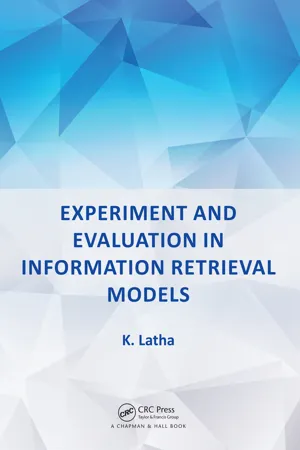
- 282 pages
- English
- ePUB (mobile friendly)
- Available on iOS & Android
Experiment and Evaluation in Information Retrieval Models
About This Book
Experiment and Evaluation in Information Retrieval Models explores different algorithms for the application of evolutionary computation to the field of information retrieval (IR). As well as examining existing approaches to resolving some of the problems in this field, results obtained by researchers are critically evaluated in order to give readers a clear view of the topic.
In addition, this book covers Algorithmic Solutions to the Problems in Advanced IR Concepts, including Feature Selection for Document Ranking, web page classification and recommendation, Facet Generation for Document Retrieval, Duplication Detection and seeker satisfaction in question answering community Portals.
Written with students and researchers in the field on information retrieval in mind, this book is also a useful tool for researchers in the natural and social sciences interested in the latest developments in the fast-moving subject area.
Key features:
Focusing on recent topics in Information Retrieval research, Experiment and Evaluation in Information Retrieval Models explores the following topics in detail:
-
- Searching in social media
-
- Using semantic annotations
-
- Ranking documents based on Facets
-
- Evaluating IR systems offline and online
-
- The role of evolutionary computation in IR
-
- Document and term clustering,
-
- Image retrieval
-
- Design of user profiles for IR
-
- Web page classification and recommendation
-
- Relevance feedback approach for Document and image retrieval
Frequently asked questions
Information
Table of contents
- Cover
- Half Title
- Title Page
- Copyright Page
- Contents
- Preface
- Acknowledgments
- About the Author
- Section I: Foundations
- Section II: Preliminaries
- Section III: Demand of Evolutionary Algorithms in IR
- Section IV: Model Formulations of Information Retrieval Techniques
- Section V: Algorithmic Solutions to the Problems in Advanced IR Concepts
- Section VI: Findings and Summary
- Appendix: Abbreviations, Acronyms and Symbols
- Bibliography
- Index